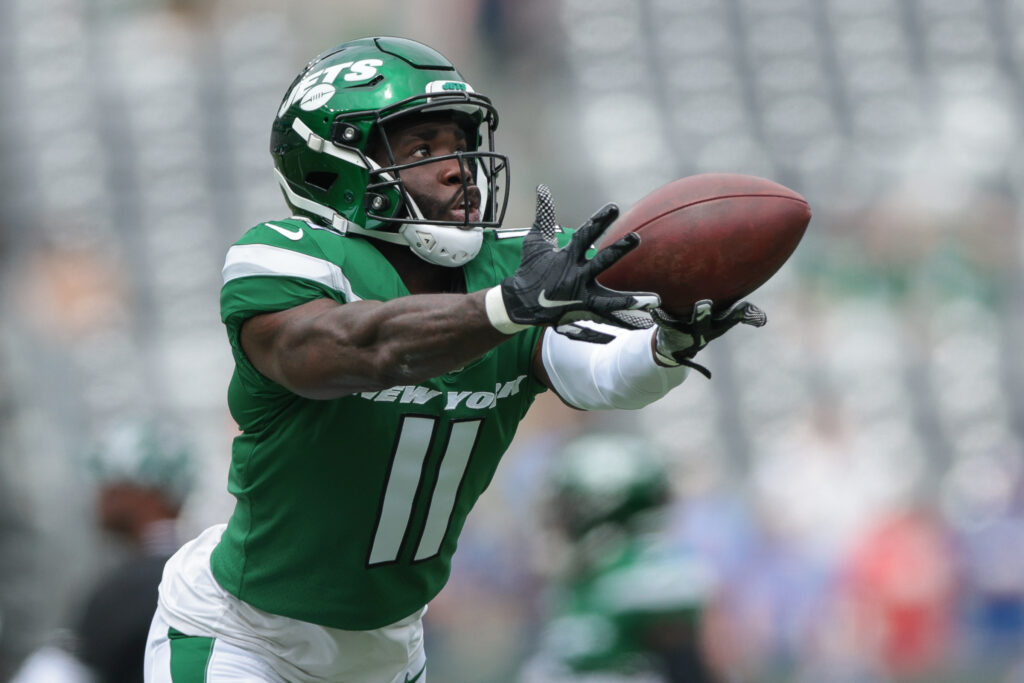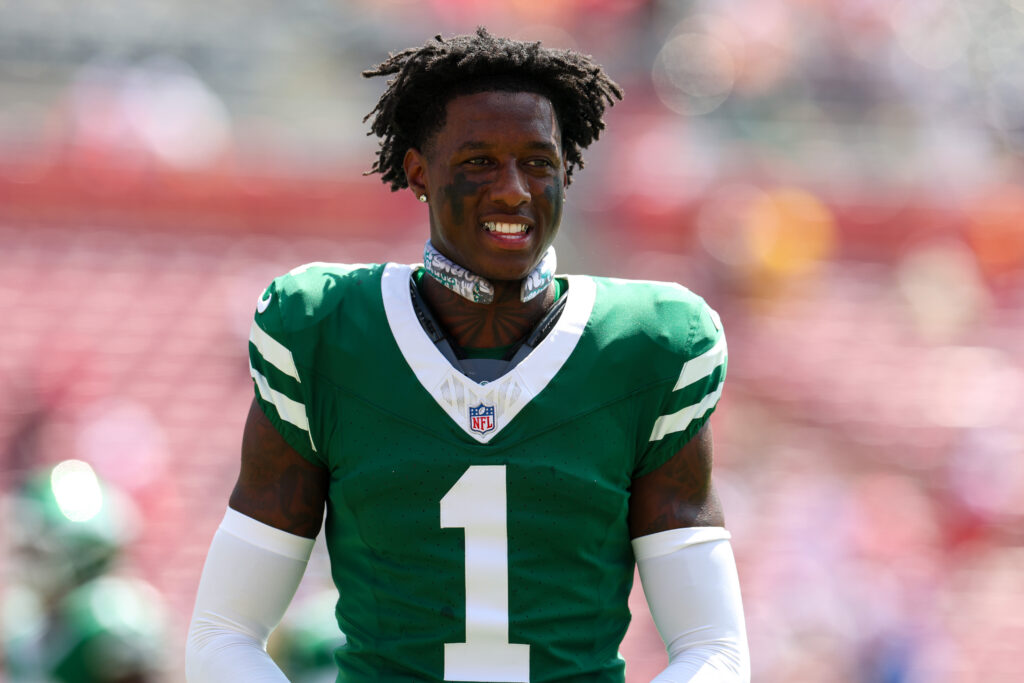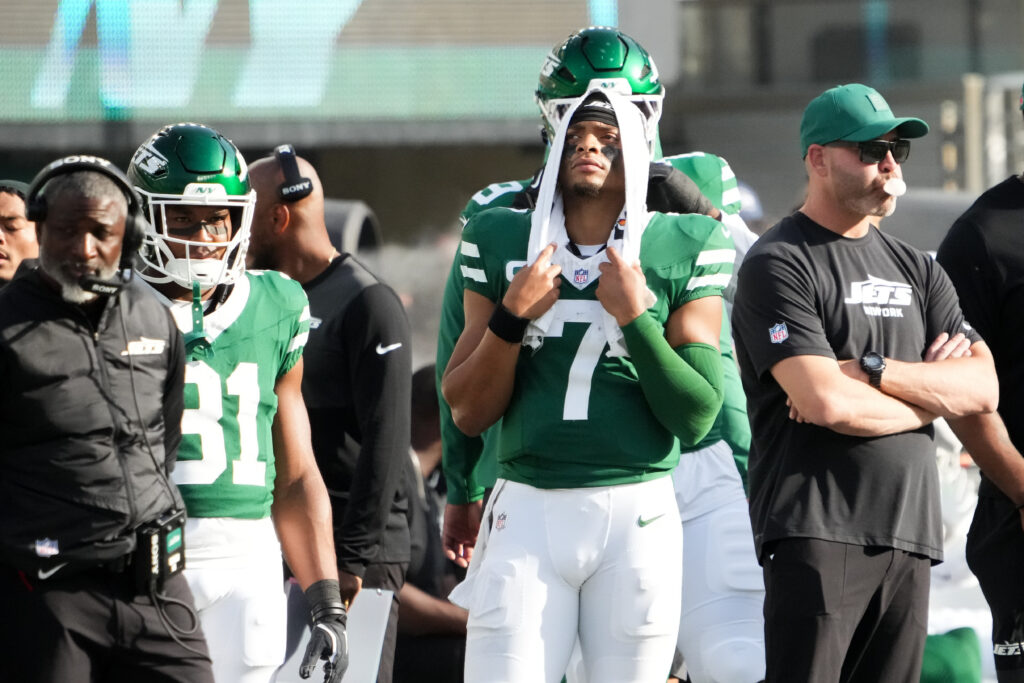When fans think of the New York Jets, what’s the first pain they think of? The obvious answer is our poor quarterback history. But there’s another position group that is right up there with poor quarterback evaluation, and that is the lack of development from receivers over the years. When it comes to drafting wide receivers, the Jets have consistently struggled to find long-term success. For decades, the franchise has poured valuable draft capital into the position, only to see prospects flame out due to injuries, inconsistency, or off-field issues.
Jets wide receiver draft busts include recent examples like Malachi Corley (2024) and Elijah Moore (2021), as well as earlier players such as Lam Jones (1980) and Stephen Hill (2013). These players are considered busts due to poor performance, injuries, or early departures from the team, failing to live up to the expectations associated with their draft positions and the investment made in them. Let’s deep dive into some of these players.
Jets’ Wide Receiver Draft and Free Agent/Trade Busts
Recent Wide Receiver Busts
These are some of the more recent mid-round draft pick prospects that never panned out for the Jets. These are premium round draft picks that are expected to produce, if not right away, within a few years upon getting drafted.
Malachi Corley (2024, Round 3)
Traded up to the 65th pick to land the “YAC King,” Corley was billed as a perfect fit for the Jets’ offense. But in just 16 months, he was cut after a rookie season with only three receptions. Off-field concerns and an inability to adapt to the pro game made this one of the quickest busts in recent memory. To cut a draft pick so quickly is very telling of how much of a mistake the franchise made selecting him in the first place. He was also from the previous tenure under Joe Douglas, so Mougey and company had no ties to him.
Elijah Moore (2021, Round 2)
Moore flashed as a rookie, showing route-running polish and playmaking ability. But tensions behind the scenes, particularly a reported clash with fellow wideout Garrett Wilson, and declining production led to a trade to the Cleveland Browns in 2023. He’s produced more in his time after the Jets than ever with the team, but still not the player he ever expected to be coming out of Ole Miss. His Jets tenure was defined more by potential than performance, which is the story of the franchise’s history.
Denzel Mims (2020, Round 2)
Viewed as a high-upside target with size and speed, Mims never found a consistent role in New York’s offense. Plagued by injuries and poor fit with multiple offensive systems, he was eventually traded, then waived by three other NFL teams. Mims is now continuing his career in the UFL, a far cry from his second-round expectations without any real chance of making it back to the league.
Stephen Hill (2013, Round 2)
Hill had the physical tools, size, speed, and athleticism, but he couldn’t stay healthy or develop reliable hands. Across two seasons, he managed just 45 catches and quickly faded out of the league. He was a height, weight, and speed specialist that had unlimited potential coming out of Georgia Tech, but never answered the bell. The Jets thought they had the next Calvin Johnson, same school, but were sadly mistaken.
Devin Smith (2015, Round 2)
Smith was the first in a modern string of Jets WR draft misses. An elite deep threat at Ohio State, he suffered multiple ACL injuries and never found footing in the pros. Smith appeared in just 14 games over two years in New York, contributing little before moving on. He was a big part of the Ohio State national championship team, leading them in yards and being Cardale Jones’ go-to guy during that run. Many argue that run is what helped his stock rise more than it was actually warranted.
Historical Wide Receiver Busts
These are just a few more examples of Jets receivers that just never lived up to the expectations that came with them. Whether it was via the draft or free agency/trade, some players just couldn’t play in the New York market or were just past their prime. Let’s take a look at a few:
Lam Jones (1980, Round 1)
Drafted No. 2 overall, Lam Jones was a world-class sprinter who never developed into a reliable receiver. Over five underwhelming seasons, he became one of the most infamous busts in team history — a cautionary tale of speed over substance.
Santonio Holmes (2010)
Acquired with high hopes after his Super Bowl MVP run with the Steelers, Holmes’ stint with the Jets was filled with injuries, locker room drama, and unmet expectations. He never had more than 746 yards and 50 catches in his four-year career with the Jets. Despite flashes, he never lived up to the hype.
Braylon Edwards (2010)
Though not a draft pick, Edwards was a significant acquisition meant to solidify the receiving corps. He had one somewhat solid year, having roughly 900 yards and seven touchdowns for Mark Sanchez, but other than that, his tenure was quick. He delivered a few big moments, especially in the 2010 playoff run, but overall failed to meet expectations tied to his pedigree and price.
Plaxico Burress (2011)
Another acquisition in the offseason, but a big-name player that couldn’t produce the same numbers as in years prior. Granted, when we did get Plaxico, he was 34 and had two years of not playing due to violating the league’s personal conduct policy. This was just another player of false hope for Jets fans; that was a player to bring excitement, only to be let down.
Final Thoughts
The Jets’ wide receiver woes in the draft span generations from Jones in the 1980s to Corley in 2024. There were others not even discussed, such as Chad Hansen, Ar’Darius Stewart, and even Jalen Saunders. I know it seems like we’re analyzing every prospect, but think about all of these mid-round receiver prospects discussed, and not one of them ever really panned out. That’s about 10+ years of not even getting lucky with any of those players being serviceable enough to get a second contract.
Now, when discussing a player as a “bust”, that doesn’t always mean it was always on the player. Other factors go into it, as always, such as unfortunate injuries and mismanaging the players, whether that’s scheme or development trajectory. Despite changes in front office leadership and coaching staff, the pattern remains alarmingly consistent: missed evaluations, poor development, and disappointing results.
Until the franchise can break this trend, wide receiver will remain a glaring caution light in every Jets draft discussion. This has turned into another position where hope too often turns into heartbreak.
Main Image: Vincent Carchietta-Imagn Images



